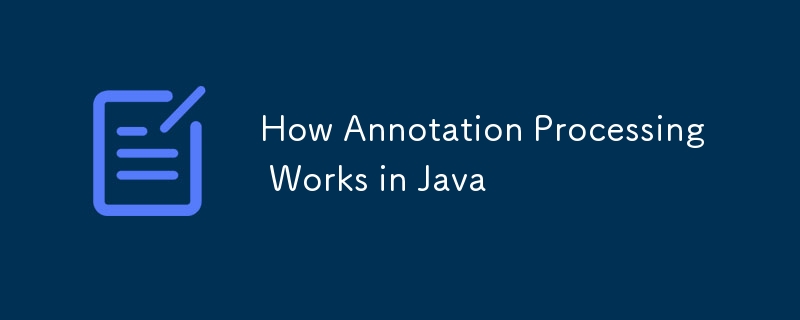Annotation processor is an extended mechanism in the Java compilation stage, used to scan and process annotations in the source code, and can generate new code or preprocess it. Its core functions include: 1. When defining annotations, you need to specify the retention policy and target element type; 2. Implement the AbstractProcessor class and rewrite key methods such as getSupportedAnnotationTypes, getSupportedSourceVersion and process; 3. Register the processor to declare a fully qualified name through a configuration file in the META-INF/services directory. Annotation processors are widely used in frameworks, such as Dagger, Butter Knife and Room, and are used for dependency injection, database access and other functions. When using it, you should pay attention to avoid dependency order, modifying existing code, complex logic and testing difficulties. If the annotation does not take effect, check the @Retention setting, processor registration status, and whether the annotation processing is enabled by the build tool.

The annotation processing mechanism in Java is actually not mysterious. It is essentially an expansion capability provided by the Java compiler during the compilation stage. Through the Annotation Processor, we can read the annotation information in the code during the compilation period, generate a new Java file or perform other preprocessing operations. Many frameworks such as Dagger, Butter Knife and Room rely on this mechanism to implement dependency injection or database access.

What is an annotation processor?
Annotation processor is a special tool that runs during the Java compilation phase and can scan and process annotations in the source code. Its core interface is javax.annotation.processing.Processor , which we can customize the processor by inheriting AbstractProcessor class.

The Java compiler will call these processors, pass in all elements marked by specific annotations (such as classes, methods, fields, etc.), and then the developer will decide how to handle this information.
To give a simple example: When you use the @Override annotation, the Java compiler will check at the compilation stage whether the method actually overrides the parent class's method. This is a built-in annotation processing logic.

How to write a custom annotation processor?
To implement an annotation processor, the following steps are usually required:
- Definition annotation
- Implement
AbstractProcessor - Register the processor
Definition annotation
You can create a runtime reserved annotation, or it can be used only for compilation processing. For example:
@Retention(RetentionPolicy.SOURCE)
@Target(ElementType.TYPE)
public @interface MyAnnotation {
String value();
}Implement AbstractProcessor
Next, you need to inherit AbstractProcessor and rewrite the key methods:
public class MyAnnotationProcessor extends AbstractProcessor {
@Override
public Set<String> getSupportedAnnotationTypes() {
return Collections.singleton(MyAnnotation.class.getCanonicalName());
}
@Override
public SourceVersion getSupportedSourceVersion() {
return SourceVersion.RELEASE_8;
}
@Override
public boolean process(Set<? extends TypeElement> annotations, RoundEnvironment roundEnv) {
for (TypeElement annotation : annotations) {
Set<? extends Element> elements = roundEnv.getElementsAnnotatedWith(annotation);
for (Element element : elements) {
// Handle classes, methods, etc. with annotations}
}
return true;
}
}Register the processor
You can create a META-INF/services/javax.annotation.processing.Processor file in the resource directory, and write your processor's fully qualified name, so that the compiler knows which processor to load.
What can annotation processors do?
The most common uses of annotation processors include:
- Automatically generate code (such as ButterKnife)
- Verify code structure (such as Lombok's non-null check)
- Do some configuration processing in advance (such as Dagger's dependency graph construction)
For example, Dagger analyzes @Inject annotation through an annotation processor during compilation, generates corresponding dependency injection code to avoid performance losses caused by runtime reflection.
In addition, if you are developing Android applications, the Room framework also generates database-related code through annotation processors at compile time, so you do not need to parse SQL statements at runtime.
Notes and FAQs
There are several error-prone places to pay attention to when using annotation processors:
- Don't rely on order : The order of execution between multiple processors is uncertain.
- Try not to modify existing code : annotation processors are more suitable for generating new code rather than modifying existing classes.
- Avoid complex logic : The processor is running at the compilation stage, and complex calculations may affect the compilation speed.
- Testing difficulty : Because it runs during the compilation period, debugging is not as convenient as ordinary code.
If you find that the annotation is not effective, you can check the following points:
- Is the annotated
@Retentionset toSOURCEorCLASS - Is the annotation processor registered correctly?
- Is there any annotation processing enabled for building tools (such as Gradle)
Basically that's it. Mastering the principles and usage of annotation processors can give you a deeper understanding of the mechanisms behind many modern Java frameworks.
The above is the detailed content of How Annotation Processing Works in Java. For more information, please follow other related articles on the PHP Chinese website!

Hot AI Tools

Undress AI Tool
Undress images for free

Undresser.AI Undress
AI-powered app for creating realistic nude photos

AI Clothes Remover
Online AI tool for removing clothes from photos.

Clothoff.io
AI clothes remover

Video Face Swap
Swap faces in any video effortlessly with our completely free AI face swap tool!

Hot Article

Hot Tools

Notepad++7.3.1
Easy-to-use and free code editor

SublimeText3 Chinese version
Chinese version, very easy to use

Zend Studio 13.0.1
Powerful PHP integrated development environment

Dreamweaver CS6
Visual web development tools

SublimeText3 Mac version
God-level code editing software (SublimeText3)

Hot Topics
 Selecting Specific Columns | Performance Optimization
Jun 27, 2025 pm 05:46 PM
Selecting Specific Columns | Performance Optimization
Jun 27, 2025 pm 05:46 PM
Selectingonlyneededcolumnsimprovesperformancebyreducingresourceusage.1.Fetchingallcolumnsincreasesmemory,network,andprocessingoverhead.2.Unnecessarydataretrievalpreventseffectiveindexuse,raisesdiskI/O,andslowsqueryexecution.3.Tooptimize,identifyrequi
 What is the `enum` type in Java?
Jul 02, 2025 am 01:31 AM
What is the `enum` type in Java?
Jul 02, 2025 am 01:31 AM
Enums in Java are special classes that represent fixed number of constant values. 1. Use the enum keyword definition; 2. Each enum value is a public static final instance of the enum type; 3. It can include fields, constructors and methods to add behavior to each constant; 4. It can be used in switch statements, supports direct comparison, and provides built-in methods such as name(), ordinal(), values() and valueOf(); 5. Enumeration can improve the type safety, readability and flexibility of the code, and is suitable for limited collection scenarios such as status codes, colors or week.
 Applying Semantic Structure with article, section, and aside in HTML
Jul 05, 2025 am 02:03 AM
Applying Semantic Structure with article, section, and aside in HTML
Jul 05, 2025 am 02:03 AM
The rational use of semantic tags in HTML can improve page structure clarity, accessibility and SEO effects. 1. Used for independent content blocks, such as blog posts or comments, it must be self-contained; 2. Used for classification related content, usually including titles, and is suitable for different modules of the page; 3. Used for auxiliary information related to the main content but not core, such as sidebar recommendations or author profiles. In actual development, labels should be combined and other, avoid excessive nesting, keep the structure simple, and verify the rationality of the structure through developer tools.
 What is the JDK?
Jun 25, 2025 pm 04:05 PM
What is the JDK?
Jun 25, 2025 pm 04:05 PM
JDK (JavaDevelopmentKit) is a software development environment for developing Java applications and applets. It contains tools and libraries required to compile, debug and run Java programs. Its core components include Java compiler (javac), Java runtime environment (JRE), Java interpreter (java), debugger (jdb), document generation tools (javadoc) and packaging tools (such as jar and jmod). Developers need JDK to write, compile Java code and develop with the help of IDE; without JDK, Java applications cannot be built or modified. You can enter javac-version and java-version in the terminal
 VSCode debugger for Java setup guide
Jul 01, 2025 am 12:22 AM
VSCode debugger for Java setup guide
Jul 01, 2025 am 12:22 AM
The key steps in configuring the Java debugging environment on VSCode include: 1. Install JDK and verify; 2. Install JavaExtensionPack and DebuggerforJava plug-in; 3. Create and configure the launch.json file, specify mainClass and projectName; 4. Set up the correct project structure to ensure the source code path and compilation output are correct; 5. Use debugging techniques such as Watch, F8/F10/F11 shortcut keys and methods to deal with common problems such as class not found or JVM attachment failure.
 XML rules: Common errors to avoid
Jun 22, 2025 am 12:09 AM
XML rules: Common errors to avoid
Jun 22, 2025 am 12:09 AM
Methods to avoid XML errors include: 1. Ensure that the elements are nested correctly, 2. Escape special characters. Correct nesting avoids parsing errors, while escape characters prevent document corruption, using an XML editor can help maintain structural integrity.
 How do I set up VS Code for Java development?
Jun 29, 2025 am 12:23 AM
How do I set up VS Code for Java development?
Jun 29, 2025 am 12:23 AM
To use VSCode for Java development, you need to install the necessary extensions, configure the JDK and set up the workspace. 1. Install JavaExtensionPack, including language support, debugging integration, build tools and code completion functions; optional JavaTestRunner or SpringBoot extension package. 2. Install at least JDK17 and verify through java-version and javac-version; set the JAVA_HOME environment variable, or switch multiple JDKs in the status bar at the bottom of VSCode. 3. After opening the project folder, make sure the project structure is correct and enable automatic saving, adjust the formatting rules, enable code checking, and configure the compilation task to optimize the opening.
 Windows search bar not typing
Jul 02, 2025 am 10:55 AM
Windows search bar not typing
Jul 02, 2025 am 10:55 AM
When the Windows search bar cannot enter text, common solutions are: 1. Restart the Explorer or computer, open the Task Manager to restart the "Windows Explorer" process, or restart the device directly; 2. Switch or uninstall the input method, try to use the English input method or Microsoft's own input method to eliminate third-party input method conflicts; 3. Run the system file check tool, execute the sfc/scannow command in the command prompt to repair the system files; 4. Reset or rebuild the search index, and rebuild it through the "Index Options" in the "Control Panel". Usually, we start with simple steps first, and most problems can be solved step by step.






